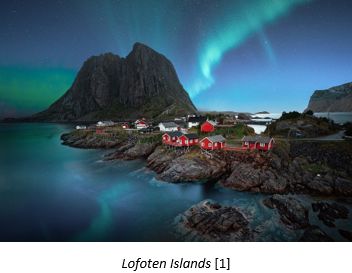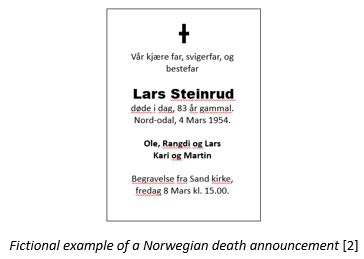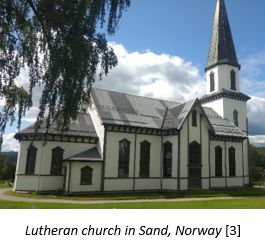Homelands in Norway – Part 2
 26
26Mar

Visiting the homeland of an ancestor can be a fantastic experience! Getting to see and experience a little bit of what they saw and experienced can be a powerful way to connect with them. In the last post, several resources were given for how to learn about the area where your ancestor lived. Some of the resources and ideas in that post also apply to taking a trip to the homelands in Norway. A trip abroad, especially a family history trip, requires a great deal of planning and forethought. Here are some suggestions and advice in case a trip to Norway is on your family history bucket list.
Homelands in Norway
Regular Trip vs. Family Trip
The simplest type of trip to plan involves contacting a travel agency who coordinates your time abroad. In Norway, you would spend time in the major cities and likely go on specific tourist attractions like the Hurtigruta—a boat tour of Norway’s coast. Unfortunately, these types of visits to Norway do not typically allow for a family history component. Nevertheless, there are a wide variety of possibilities. With some advanced planning and a customizable travel situation, you can experience the best of Norway and experience a personal connection with your ancestors’ homeland. For general trips to Norway and even some customizable options, look for a company that specializes in Scandinavian travel. They have a long history of excellent Scandinavian tours.
Connect with a Person
Being a tourist in a foreign country is a lot easier with a guide. On a normal trip, your paid-for package likely includes a guide or escort. In order to plan and enjoy a family history component on your trip, you will need to find your own guide for the time you spend exploring.
Find a relative
The best guide for a family history trip will always be a willing local relative. A relative will have a more intimate connection with you and feel more responsible for your well-being. While most Norwegians speak English and it is relatively easy to get around without speaking Norwegian, a local relative’s linguistic ability and knowledge of the area will make getting around infinitely easier. They will also likely have personal knowledge of the family history and will be able to show and share specific places, buildings, and artifacts related to your family’s history. It is also easier to make a return trip or have continued interaction if you are connected to a relative.
To find a living Norwegian relative, normal genealogical research is essential. With publicly available documents, trace family descendants as close to present time as possible. Typically, this involves finding family in the 1910 Norway census and church records up to the 1920s/1940s. Once that is done, there are other sources that help with identifying living and/or recently deceased people.
Døde 1951-2014 – Digitalarkivet.no
This is a nearly complete index of all the deaths in Norway from 1951-2014. Most of the youngest generation found on the 1910 census would be on this list if they lived to an average age. The index does not include any information about surviving relatives, but the death date is important for further research.
Newspapers – Nb.no
The National Library of Norway has a vast digitized newspaper collection. Some of the newspapers are copyright protected and only viewable while in the physical library or restricted to a Norwegian computer. However, many of the newspapers are free to view anywhere. With an exact death date or unique name and a location, it may be possible to find an obituary/death announcement for a relative deceased within the time period above (1951-2014).

Obituaries/Death Announcements – various
Obituaries are the most helpful for finding living relatives because they often identify surviving relatives. However, they are less common than death announcements. Death announcements can be helpful but also frustratingly limited. A death announcement in Norway contains the name and death date of the deceased individual and often includes the given names of their closest surviving relatives. The lack of surnames can make it difficult to sort out relationships, but there is generally an order to the names as they are listed in the death announcement. Surviving spouses are typically listed first, then living children and in-laws, then grandchildren, if they had any, or other close relatives. The relationships can also be deduced from the titles listed after the name. It is tradition in Norway to say something like, “Thorsten Larsen – beloved spouse, kind father, grandfather, brother, and brother-in-law.” These relationships can be clues to the exact relationships of the named surviving relatives because the order of the titles typically corresponds to the order of the names of relatives.
Obituaries/death announcements were historically printed in newspapers but may be found on memorial websites in modern times. For newspapers, search the National Library of Norway catalog first, but also look for databases covering the specific newspaper in the area where your relative died. For example, obituaries from the Odal region are likely found in the Glåmdalen newspaper. The Slekt og Data website has a database (requires membership) for obituaries in Glåmdalen from 1943-2018.
Address books – various
Address books are mostly useful for the Oslo area. They can be difficult to get a hold of or may not exist for most of Norway, but the Oslo area has address books from the late 1800s to the late 1900s. The books for Oslo are digitized and free to view on both digitalarkivet.no and nb.no. While the address books only give name and address, they can be useful for tracking relatives in conjunction with other sources over time.
Yellow Pages – gulesider.no
Search for the name of a suspected living relative in Norway’s yellow pages to find a current address and phone number. The yellow pages are not all-encompassing but are one of the ways to find contact information for living relatives.
Social Media – Facebook, etc.
Once the name of a suspected living relative has been found, search for them on Facebook and other social media. Not only is social media a great way to make first contact, but you can also learn a little about the person before you reach out. You might even be able to find other relatives through them.
Connect with an organization
If it is not possible to contact a living relative, or the living relatives are not interested in further contact, then consider reaching out to a historical organization. Historical organizations are by nature composed of people interested in the local history of an area. They are often passionate individuals who are happy to help others connect with local history.
Bygdelag - http://www.fellesraad.com/
A bygdelag is an American organization composed of people whose Norwegian ancestors come from the same general area. There is a bygdelag for every part of Norway and they are great for connecting to other people interested in their Norwegian ancestry. Often, people in a bygdelag have already visited their ancestral homeland in Norway and have great advice for those considering a trip to Norway. They may even be able to point towards helpful resources or have connections in that area of Norway. Search the Fellesraad website to find the bygdelag that applies to you.
Historisk forening or lag
Another resource is the local historical unit in Norway. While there are several large organizations in Norway like Slekt og Data or the Norsk Slektshistorisk Forening, there are also many smaller historical societies called a lag. If a relative cannot be found, someone from an organization like this is often the next best thing. They will have ties to the local area, a passion for history, and the ability to help you navigate the area if they are willing.
Museum association
If there is a not a local lag for your family’s ancestral area, check to see if there is a museum nearby. Museums in Norway often have a “friends of the museum” association that could be potentially helpful.
Example – For my visit to Norway, I interned at a local museum and friendly people from the Friends of the Museum organization gave us tours of the area, including visiting my family’s ancestral farms.
See the Right Places
There is never a lack of things to see in Norway. But if you are going to visit the area where your ancestor lived, you want to make sure you see family history related places and buildings.
Visit the farm if possible
As mentioned in the part 1 of this series, nearly all Norwegian families were historically tied to a specific farm. If you can, visit your family’s ancestral farm. Since many of these farms are still occupied and in use today, it is helpful to have a contact in Norway who would be willing to reach out to the current owner of the farm and get permission for you to visit. Ask about older buildings on the farm, historical boundaries, or if there are any old pictures of the farm.

See the local church
From the 1500s, the Lutheran church was the state church for Norway. Norwegian life often revolved around their participation in the church and many old churches still stand today. Check to see how long the local church has been around and see if you can get a tour. You might be able to walk inside the church in which your ancestors worshipped.
Go to a local museum
Local museums are a great way to get to know the history of an area. They will have pictures and displays, will explain and show how important historical events affected the people living in the area, and will explain what day-to-day life was like.
Visit a regional archive – find the church books
Historically, many of the most significant events in a Norwegian’s life were recorded in the local church book. Their birth/christening, confirmation, marriage, and death/burial would all be written down by the local priest. These church books still survive in the local and regional archives of Norway. If you get a chance, plan to visit one of the archives and see if you can hold the church book in which your ancestor’s life was recorded.
Conclusion
Do not miss out on the opportunity to visit your Norwegian ancestors’ homelands and experience the deeply personal connection that comes with walking the same ground they walked. Need help finding a living relative or contacting a historical organization? Price’s experts can help you find relatives and learn about their ancestral farms.
By Forrest
Sources:
[1] https://pixabay.com/no/photos/lofoten-hamnoy-landskap-4827611/.
[2] Image courtesy of Forrest Emmett
[3] Photo courtesy of Forrest Emmett.
Do you have any questions about Homelands in Norway that we weren't able to answer in this two part series? If so, let us know in a comment below!
